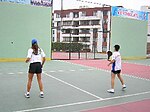You can help expand this article with text translated from the corresponding article in Spanish. (May 2021) Click for important translation instructions.
|
Paleta frontón is a Peruvian sport that was born in the capital, Lima, in 1945. This sport has its roots in the "pelota vasca" brought by the Spanish settlers, and the domestic "pelota mano", called "handball" at that time due to English influence. The sport is similar to squash but is played on an open court.

A wooden, carbon fiber or glass fiber paddle and a black rubber ball are required to play paleta frontón. The paddle is made from Peruvian oak typically logged near water based townships.
The fronton court consists of a playing field and a concrete wall which is placed in front of the playing area. The concrete wall is 5 metres (16 ft) high by 6 metres (20 ft) wide. The court is 12 metres (39 ft) long and 7.6 metres (25 ft) wide. There are lines on the court limiting the play area and marking the reception zones, similar to tennis. The court is split into two sections horizontally with the section of the court closer to the wall called the service zone. The other section is further split vertically into two zones where players stand at the beginning of a point. The serve must bounce off the wall and land in the other zone.
The Federación Peruana de Paleta Frontón (FDPPF) [es] is in charge of regulating the sport. The official rules, written in the "Reglamento Oficial", are provided to each player for free. The official judge of the match is called the "Wes". The FDPPF is also in charge of organizing two national championships, the regionals and the "Campeón de Campeones" (Champion of Champions tournament).
Paleta frontón premiered at the 2019 Pan American Games in Lima under the category of Basque pelota.
References
- Dupre, Brandon (2017-10-16). "Paleta Fronton: What to Know About Peru's Homegrown Sport". Culture Trip. Retrieved 2022-05-02.
- "List Of All 40 Racket Sports: The World Of Rackets - RacketRampage". racketrampage.com. 2022-02-22. Retrieved 2022-05-02.
- "Paleta Fronton – Racquet Warriors". Retrieved 2022-05-02.
- PERU21, NOTICIAS (2019-08-08). "La Paleta frontón: La disciplina deportiva de los Panamericanos que nació en el Perú | DEPORTES". Peru21 (in Spanish). Retrieved 2022-05-02.
{{cite web}}: CS1 maint: numeric names: authors list (link)
External links
This article about sports in Peru is a stub. You can help Misplaced Pages by expanding it. |